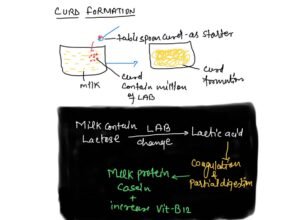Welcome to kashibiology. In this post we will understand the beneficial role of microbes besides this firstly we should know what are the microbes, their cellular nature and their different groups.
Organisms which are Microbes
Microbes are those organisms which are not easily seen by naked eye. They need to electron microscope or microscope to clear visibility. Microbes are mostly unicellular microscopic organism belonging to different groups of plants, animals as well as prokaryotic organisms.
Most of the microbes are prokaryotic in nature while some are eukaryotic also. some of the microbes are non cellular structure such as Viruses, Viroids and Prions.
In prokaryotic microorganisms group bacteria Mycoplasma and Cyanobacteria or blue green algae present while in eukaryotic microorganisms Protozoan’s, Fungi, Dinoflagellates and other Protistan as well as unicellular algae with simple designing are present.
Here we understand the role of microorganism for human welfare because in chapter human health and disease we have already learned about the disease causing microorganisms.
What is the distribution of Microorganisms?
- Microorganisms are cosmopolitan nature that is found in everywhere, in the soil water, air, dust as Endoparasites or Ectoparasite on or in plants and animal body.
- Most of the microorganism belongs to diverse group of organisms such as bacteria, viruses, fungus, Cyanobacteria, Mycoplasma etc.
- In case of virus, Viroids and Prions, they are non-cellular microbes hence cannot be replicates without the host cell.
- Therefore they can’t be cultured in a Cell free system. for their growth they are always required a Host cell.
- Whereas in case of bacteria and other cellular microorganisms, they can be grown on Simple nutritive media called culture media or growth media where they replicates and form colonies.
Let’s see some important role of microbes
What are the Household microbial products?
Microbes are used by humans in many important processes like in industries agricultural Process, sewage treatment bioremediation alcohol production etc.
Some common household and industrial microbial products are as follows-
Microbes in Household Products
A number of microbes since ancient time are used to making of different type of household products. In which the most important one are the dairy products
Microbes in Dairy Products

Curd formation
- In our Indian culture system whenever we start any good our mother or parents before starting the work give a teaspoon of Dahi or Curd in our mouth why?
- Because, curd contain a very important bacteria which is called lactic acid bacteria that improve our digestion ability and if our digestive system is good then over brain is also working best and overall body is healthy.
- The bacteria lactobacillus or lactic acid bacteria are used in formation of curd from the milk. Lactobacillus bacteria produce lactic acid by breakdown of milk sugar or lactose.
- Lactic acid causes the coagulation and partial digestion of milk protein casein. Hence milk change into curd.
- For the formation of curd from the milk, a small amount of curd added to the fresh milk as starter or inoculums, which contains millions of lactobacillus bacteria.
- At suitable temperature these bacteria multiply and converting milk into curd. Lactic acid bacteria also increase the nutritional quality of curd by increasing the amount of water soluble vitamins B-12.
- These bacteria also check the disease-causing microbial population in the stomach.
- Butter milk
- Buttermilk is produced by skimmed milk in the presence of bacteria Streptococcus cremoris Streptococcus lactis and Leuconostoc the temperature requirement for butter milk formation is 22 degree Celsius for about 18 hours.

Cheese formation
The curd is separated from the liquid part and used in the formation of cheese.
Different varieties of cheese are formed by use of different types of microorganisms. Some of the cheese is known by their texture, flavor and taste.
This is due to the use of different types of microbes.
Some of the well known cheeses are-
Swiss cheese
This cheese contain large hole due to the production of large amount of carbon dioxide.
The bacterium involve in the formation is called Propionibacterium sharmanii.
Roquefort cheese
These are prepared by specific fungi called Penicillium roqueforti, which gives cheese to particular flavor.
What is the difference between ripened and unripened cheese?
Ripened cheese
Ripened cheese is prepared from unripened cheese by dipping in brine wiping and then the maturation with different type of bacteria as well as Fungi.
It will take about 1 to 16 months for the proper ripening.
The large hole in the different type of Swiss cheese and Roquefort cheese is due to the production of carbon dioxide gas.
Unripened cheese-
It is also known by name cottage cheese. It is prepared by single step fermentation process which involves mixing of skimmed milk with cheese culture.
Here the cheese culture is contains a number of bacterial strains like Lactobacillus, Acetobacter and some fungus such as Saccharomyces, Rhizopus.
In addition of rennin in enzyme after one to two hours and then curd is placed in cloth which is porous for removal of unnecessary whey part.
Yoghurt
It is also the product of microbial activity. Yoghurt produced by curdling of milk in the presence of Streptococcus thermophilus bacteria and Lactobacillus bulgaricus bacteria.
For yoghurt formation, there is a need of temperature to maintain at 45 degree Celsius for about four hours cut has a flavor of aldehyde and lactic acid.
Idli and Dosa-
I am sure that, all of you aware about these delicious South Indian foods and also might you all taste these foods either in home or restaurant.
But all of you know that, how dosa and Idli is prepared.
The raw material (dough) for idli and dosa is also the fermented products of Microbes. But which a type of microbes has used in preparation of its raw material.
It is formed by the dough which is the fermented product of bacteria. The Puffed off appearance is due to the production of carbon dioxide gas.
The bacterial species used in fermentation is Streptococcus species.
Jalebi and Uppma-
Jalebi and Uppma is also the fermented product of microbes.
Tofu, Sofu and Tempeh-
These are not indigenous Indian fermented foods but they are the fermented foods of different countries. Such as Tofu of Japan, Sofu of China and Tempeh of Indonesia.
All are the fermented products of soybean.
Soy sauce, Saucerkraut and Bamboo shoots-
Soya sauce is the brown colour salty sauce fermented product of soybean and wheat.
Sauerkraut is formed after the fermentation of find chopped pickle cabbage.
In many countries tender of bamboo shoots or a stem are directly used as vegetables as well as after fermentation they are also used as food.
Similarly are number of sausage are prepared by fermentation.
Bread formation-
The dough which is used for making bread is fermented by baker Yeast (Saccharomyces cerevisiae)
This fungus produces enzymes amylase, maltase and zymase.
These enzymes break down starch ultimately into glucose.
After fermentation of glucose, ethyl alcohol and carbon dioxide produced.
Toddy-
It is the traditional drink in many parts of Southern India. It is formed by fermentation of palm sap. When palm sap left for a few hours, it undergoes fermentation by natural existing Yeast.
Which convert sap of palm in a alcoholic beverage which containing 6% of alcohol. If palm sap left for 24 hours it becomes unusable.
In the above household products, most of them are fermented products, which are the products of microbial activity.
So let’s aware about what is the fermentation? We will not discuss in very detail but in very brief to understand the concept of fermentation.
Fermentation-
Fermentation it is the metabolic process in which glucose or carbohydrate is incompletely break down into lactic acid or alcohol.
The process of fermentation takes place in the absence of oxygen.
This is a natural pathway of glucose breakdown in almost, all the anaerobic Microbes and some of the facultative anaerobic microbes.
However the ATP formation is very less in the fomentation sometime it is also called an aerobic respiration
Microbes and our muscle cells also show anaerobic respiration, whenever amount of oxygen is not properly supply to the muscle cells which happen during the exercise or any heavy work.
Types of fermentation
On the basis of end product formation and the presence of types of microbes, the fermentation generally divided into two types namely alcoholic fermentation and lactic acid fermentation.
Alcoholic fermentation-
- In this process the carbohydrate or glucose partially break down into alcohol ethyl alcohol in the presence of appropriate Enzymes alcohol dehydrogenase.
- The alcoholic fermentation is carried out by many microbes such Yeast fungus. This fungus is also used in the commercial production of alcohol.
- We shall discuss alcoholic fermentation in very detail in coming post, under the topic microbes in beverage and antibiotic production.
Lactic acid fermentation-
- In Lactic acid fermentation process the carbohydrate or glucose in completely break down into lactic acid.
- The process is also catalyzed by enzyme which is called lactic acid dehydrogenase.
- The microbes which carried out lactic acid fermentation are lactic acid bacteria or Lactobacillus as well as the same process also takes place in our muscle cells in the lack of oxygen.
In both Lactic fermentation and alcoholic fermentation very less amount of ATP formed with the release of two molecules of carbon dioxide.
Conclusion-
Hope after reading this post you will be able to understand the role Microbes in Household Products. In the next post we shall discuss some other role in other products formation .
Thanks for reading this post.
If you have any doubt or query or any suggestion please write to us. We will try to mention in our post.
I hope your online journey goes well.

